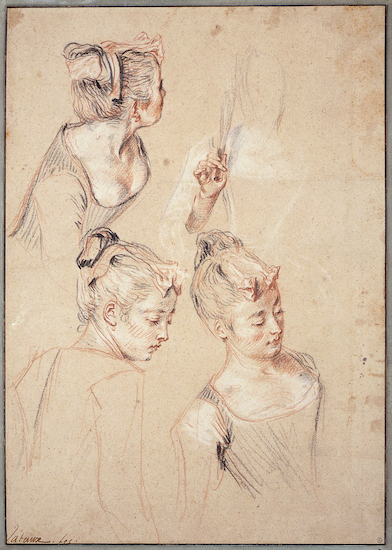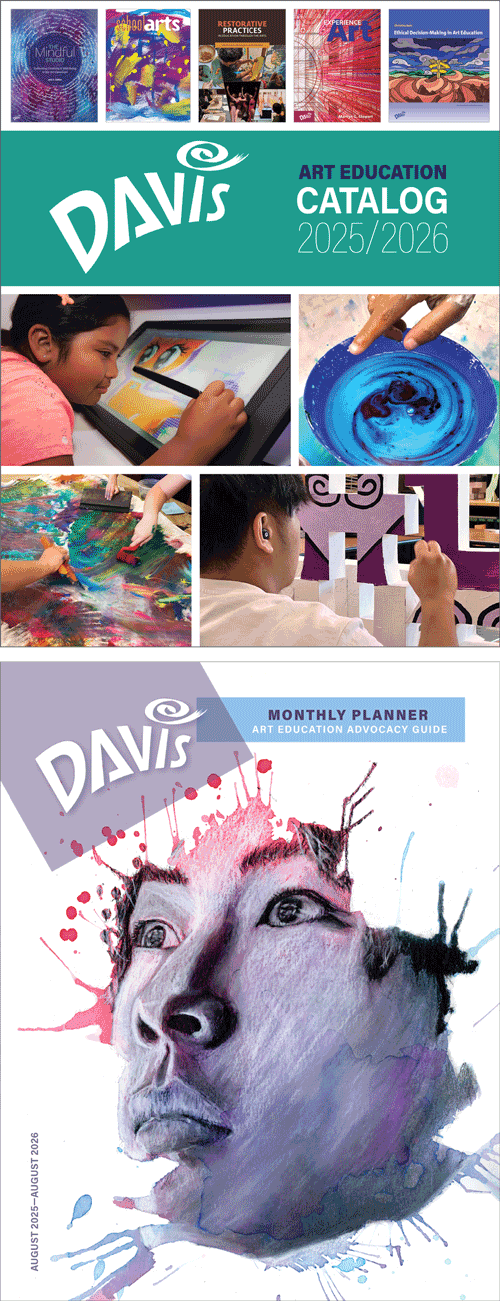Artist Birthday: Jean-Antoine Watteau
The paintings of Jean-Antoine Watteau typified the rather Baroque-lite character of French art in the first fifty years of the 1700s. After the death of Louis XIV (1715), French painting trended towards less drama, and more emphasis on elegance and light-hearted pastimes of the upper classes.
Artist Birthday for 10 October: Jean-Antoine Watteau (1684-1721 France)
 |
| Jean-Antoine Watteau, Three Studies of a Woman and Study of Her Hand Holding a Fan, ca. 1717, chalks on tan paper, 64.8 x 54.3 cm Image © 2025 Museum of Fine Arts, Boston (MFAB-201) |
Watteau produced thousands of study drawings during his short lifetime. His drawings were valued as much as his paintings. He drew few compositional studies, and, contrary to practice at the time, he did not execute figure drawings in preparation for a determined subject. He did studies of single figures, heads, hands, feet and drapery that became a repertoire from which he drew for his painting compositions. This drawing of young women captured the spontaneity of the figure. His technique of black, red, and white chalks, although he did not invent it, became synonymous with Watteau. His use of it to define form on beige or salmon paper allowed him to closely approximate skin tones struck with highlights. These figure studies ended up in the painting Entertainment in the Open Air. (Gemäldegalerie, Staatliche Museen zu Berlin, https://recherche.smb.museum/detail/867137/gesellschaft-im-freien?language=de&question=watteau&limit=15&sort=relevance&controls=none&collectionKey=GG*&objIdx=2)
Background
After the death of the French King Louis XIV in 1715, the French Baroque style lost its bombastic, dramatic character. The absolute monarch had summed up in his extravagant lifestyle the very ideas of the Baroque period: overblown power, excess and drama. Cultural life shifted from the great palace at Versailles to the townhouses of the nobility in Paris, a scene dominated by wealthy women.
The late Baroque period between 1715 and 1750 is often referred to as Rococo, from the French rocaille a type of decorative shell or rock garden arabesque motif. Painting still contained aspects of the Baroque such as strong diagonal movement and dramatic recession, but the overall effect was softer, a lighter palette, more graceful, and serene.
Where Baroque art was heralded in architecture in Italy, Rococo art was heralded in painting in France. The more intimate Rococo style was born of the move from the domination of art patronage from powerful rulers, nobility and clergy to the nouveau riche of the middle class of Paris. The style was tacitly "approved of" by Louis XV (1710-1774) in 1715 when he moved the court from Versailles to Paris. It subsequently spread through much of Europe until the middle of the century. Three French artists are primarily associated with the style in painting: Jean-Antoine Watteau, Jean-Honoré Fragonard (1732-1806), and François Boucher (1703-1770).
More than any other artist, Watteau helped shape the Rococo style in painting. The son of a roofer, little is known about his early education. Around 1702 he had moved to Paris and was soon working painting theater scenery under Claude Gillot (1673-1722). Gillot specialized in scenes inspired by the frivolous and light-hearted Italian commedia dell'arte, figures from which subsequently appeared in many of Watteau's painting. He also worked under Claude Audran (1658-1734), an interior decorator, tapestry designer and painter who had done decoration in Louis XIV's palaces at Versailles and Fontainebleau.
Under these two masters Watteau developed his mature style that incorporated much theatrical subject matter and the arabesque motifs that had begun to dominate interior design. Although Watteau was accepted into the Royal Academy (where they created the special category of Gallant Festival [Fête Gallante]for his subject matter) in 1712, he never was able to study in Italy, instead studying the works of Peter Paul Rubens (1577-1640) and Venetian Renaissance masters at the Louvre.

Comments